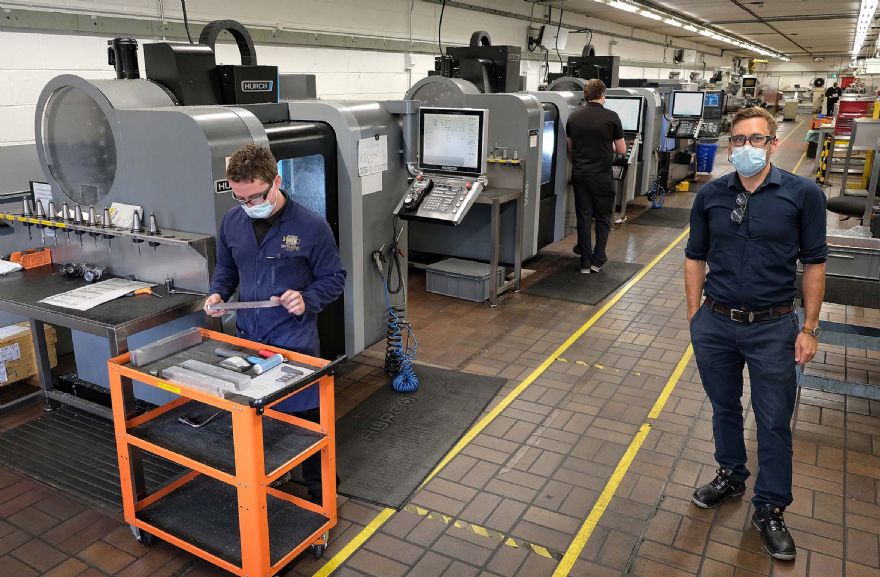
Six
Hurco three-axis vertical machining centres carry out a majority of prismatic machining in the toolroom of plastic packaging manufacturer
Berry M&H in Beccles, Suffolk. Although the firm dates back to 1973, the first Hurco machines, a VM10i and a VMX30i, did not arrive until 2015 when the assets of another toolmaking company were acquired, including its machine base.
Prior to that, manual knee-type mills in the toolroom were followed by three-axis CNC milling machines and then a succession of machining centres with automatic tool change. All of the CNC machines were fitted with the same G-code-based brand of control system to provide commonality for the convenience of the staff.
Berry M&H’s toolroom manager Kurt Knights, who has been with the company for over 20 years, said: “When we started using WinMax conversational software in the Hurco control, it made shopfloor programming far easier and quicker for our operators — and it also simplified training for new people and our apprentices alike.
“Most programs we prepare take advantage of the Hurco’s NC-Merge feature. Complex parts of a cycle for contour-milling 3D mould surfaces are output from either NCG CAM or SolidWorks CAD/CAM systems in our design department and the file is imported directly into the control.
“Conversationally programmed blocks prepared at the machine using WinMax are then automatically merged in the control with the offline content into a single program for milling the block parts of our moulds.”
Off-line code generation for a mould takes typically 10hr, while the shopfloor element is completed in around 2hr, much faster and more simply than is possible on a machining centre driven by a G-code control. It quickly became apparent that the Hurco/WinMax combination was perfect for Berry M&H’s requirements, which centre mainly on fast-turnaround production of moulds from 170 mm wide Alumec 89 billets. Most moulds comprise neck, body and base blocks manufactured from the high strength aluminium alloy, held together by a steel back plate.
New tool developmentTwo new Hurco VM5i three-axis VMCs were purchased for machining these moulds, as well as for new tool development that was formerly the province of the CNC mills, all but one of which have now been sold. The VM5i was chosen as it has a generous 457 x 356 x 356mm working volume in a compact 1.6 x 2.9m footprint.
It suited the toolroom space and layout well and was correctly sized for machining the company's moulds. Four halves at a time are fixtured, each of which takes about three hours to machine. The resulting 12-hour cycle is more than sufficient for a full light-out shift overnight.
As the size and performance of the two VM5i machines were ideal, the decision was taken in 2019 to buy a third, this time for machining items such as printing chucks, bracketry and other general, non-mould items for different departments across the Beccles site. It brought in-house previously sub-contracted milling, delivering considerable financial savings.
In November 2020, a larger Hurco VM30i with a 1,270 x 508 x 508mm working volume was purchased that Mr Knights described as “a superb machine and excellent value for money”. The investment was down to Berry M&H's decision to move more strongly into the production of bigger moulds up to 700mm wide and with up to six cavities.
There had always been a requirement for this size of tool and their production was previously sub-contracted out, so this expense is now also saved. Both Alumec 89 and 1.2316 stainless steel are used, the latter as it has good thermal conductivity and wear resistance and is also magnetic, allowing a mould to be clamped conveniently on the bed of a grinding machine.
Berry M&H designs, develops, produces and prints, to British Retail Consortium standards, a large range of plastic bottles, jars, tubs, flexible tubes, closures, caps and dispensing systems. The packaging solutions are sold into the personal care, healthcare, pharmaceutical, nutritional, pet care, automotive and household product markets.
The company has an extensive range of almost 5,000 standard products and also offers bespoke design, prototyping and moulding services. There are manufacturing sites across the UK, mainland Europe, America and Australia. Mr Knights’ department produces blow moulds and injection moulds for many of the group’s factories around Europe.